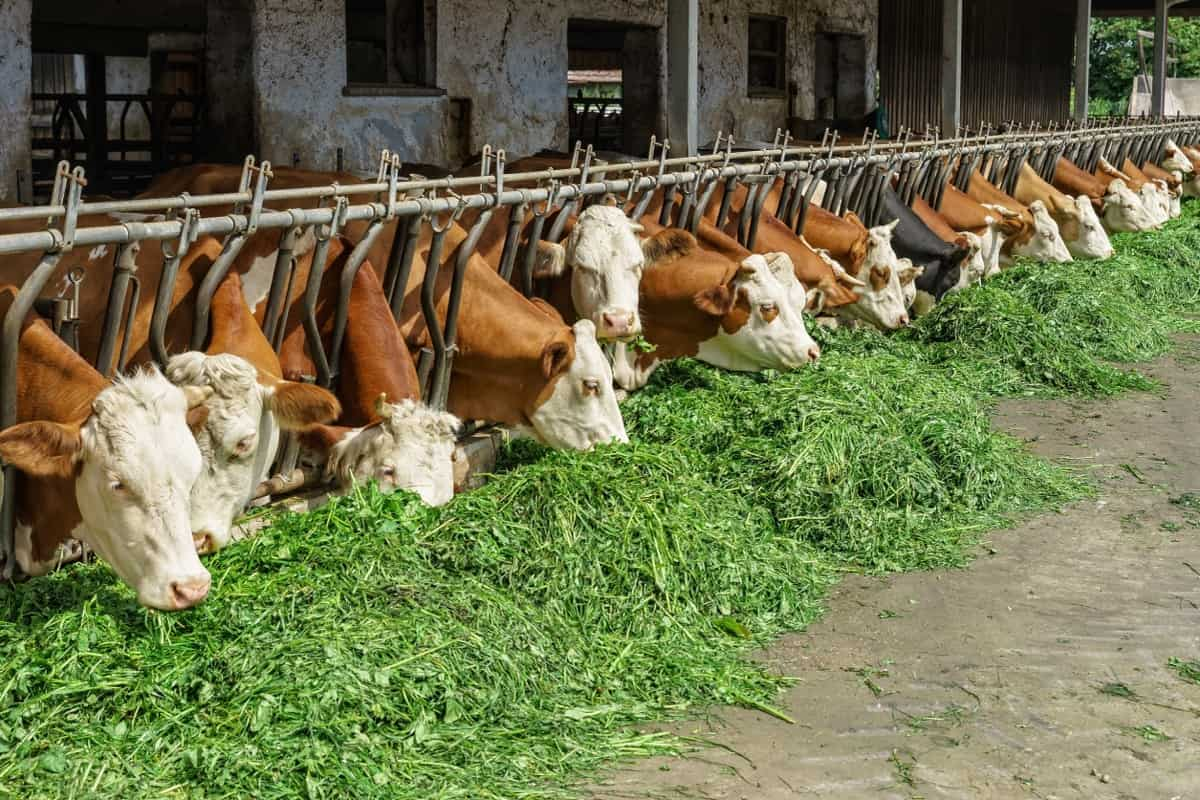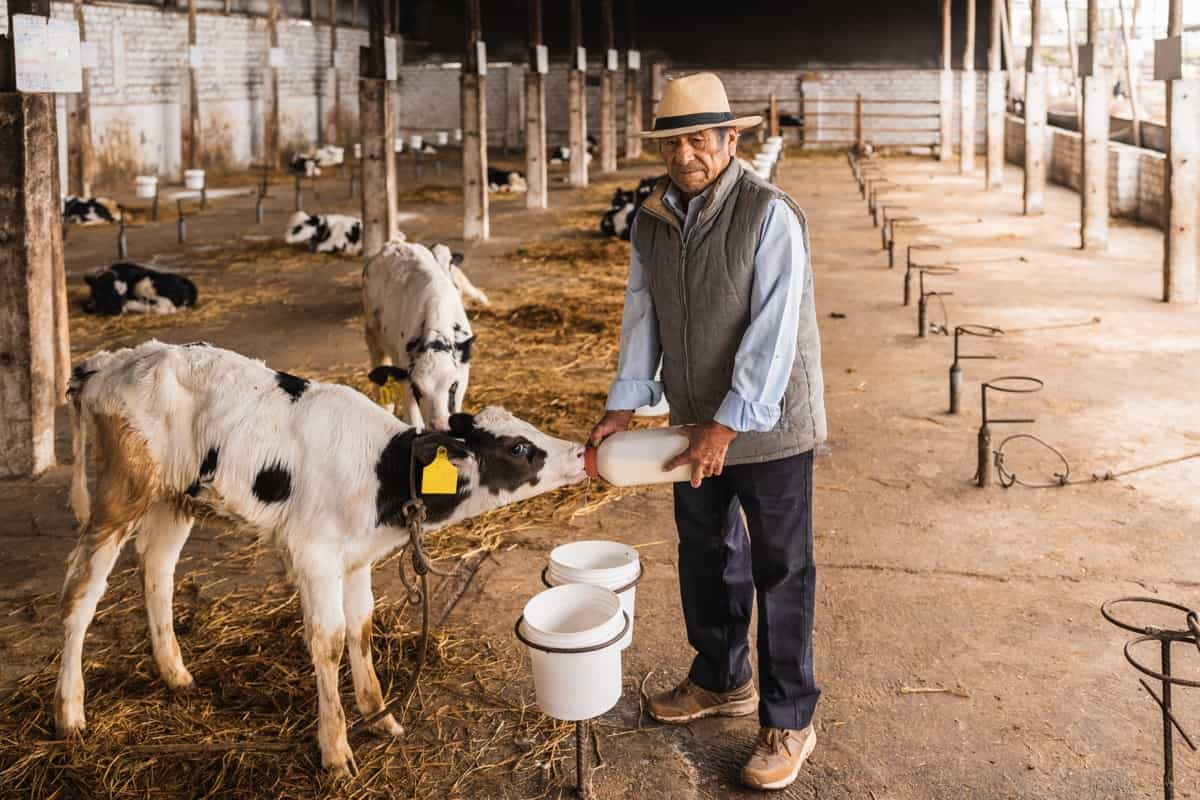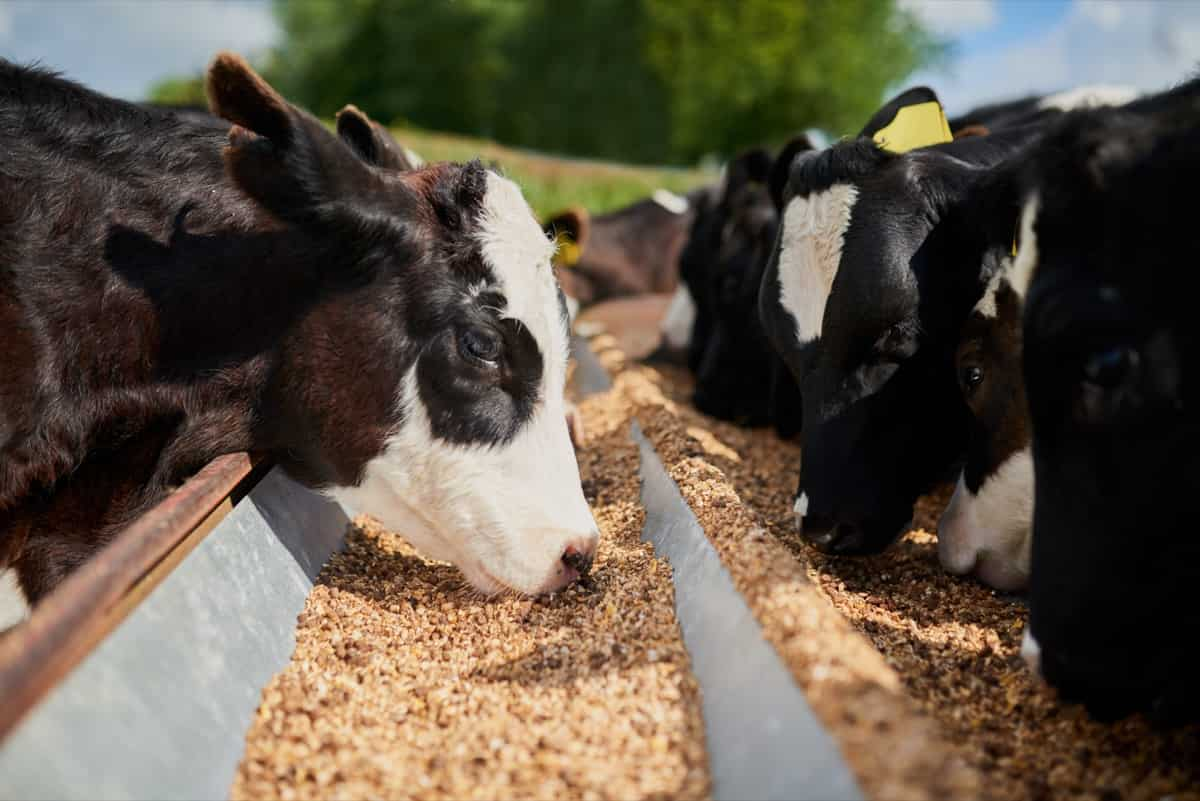The high-producing dairy cow requires a diet that supplies the nutrients for high milk production. Carbohydrates, amino acids, fatty acids, minerals, vitamins, and water are all nutrients required by the lactating dairy cow to meet the demand of the mammary gland to produce milk and milk components. However, developing a cow that will produce a high milk yield begins with the calf’s nutrition.

Feed Management in Dairy Farming
Feeding of Calves Colostrums
Whatever system is followed, colostrums, the first milk given to the calf by the cow after calving, must be given to the calf. Feed the calf between 2 and 2.5 liters of colostrum every day for the first three days after birth. It is more digestible when colostrum is given at a temperature between 37.5°C and 39°C.
Feed the milk at three or four equal intervals for the first seven days, then twice daily. Grain mixtures can be introduced at the age of 7-15 days. In the used pail, place a small handful of grain mixture to get calves accustomed to grain mixtures. After feeding milk, the calf may consume a portion or be offered a little in hand as it finishes. The whole milk given to a calf may be reduced after two weeks of age.
After the calf has become accustomed to the starter, rub a small amount on its mouth after each milk feeding for a few days. Feed the calves a mixture of oats – 35 percent, bran – 30 percent, barley – 10 percent, groundnut cake – 20 percent, and linseed cake – 5 percent. Combining ground maize with wheat bran – two parts each is also a good idea.
Feeding schedule for calves up to 6 months
| Age of Calf | Body Weight (Approx.) (Kg) | Milk Quantity (Kg) | Calf Starter Quantity (Grams) | Green Grass (kg) |
| 4 days to 4 weeks | 25 | 2.5 | 25-50 | 0.1-0.15 |
| 4-6 weeks | 30 | 3 | 50-100 | 0.15-0.2 |
| 6-8 weeks | 35 | 2.5 | 100-250 | 0.2-0.35 |
| 8-10 weeks | 40 | 2 | 250-350 | 0.35-0.5 |
| 10-12 weeks | 45 | 1.5 | 350-500 | 0.5-1 |
| 12-16 weeks | 55 | – | 500-750 | 1-2 |
| 16-20 weeks | 65 | – | 750-1000 | 2-3 |
| 20-24 weeks | 75 | – | 1000-1500 | 3-5 |
Feeding of Growing Animals (From 6 Months Old Onwards)
For calves under one year of age, supplemental concentrates and good roughage always benefit their growth. Feeding calves over one year of age high-quality roughage can significantly reduce the need for feeding concentrate. To achieve optimum growth without excessive fat deposition, roughage and concentrate must be mixed judiciously. After six months of age, calves can be fed the same concentrated mixture (14-16% Digestible Crude Protein and about 70% Digestible Nutrients) as adults.
| Age (months) | Approximate body Weight (kg) | Concentrate Mixture (kg) | Grass (kg) |
| 45175 | 70 to 100 | 1.5 to 1.75 | 5-10 |
| 42248 | 100 to 150 | 1.75 to 2.25 | 10-15 |
| 15-20 | 150 to 200 | 2.25 to 2.50 | 15-20 |
| Above 20 | 200 to 300 | 2.50 to 2.75 | 15-20 |
In case you missed it: Feed Management in Sheep: Feeding Plan, Feed Formula, and Fodder Requirements

A Feeding Schedule of Adult Cows for Different Classes (Approximate Body Weight-250 Kg)
In general, cattle require 2-3% of their body weight in dry matter, but high-yielding animals may consume more than 3%. Climate, feed processing, palatability, etc., affect dry matter consumption. A high-quality grass ration with at least six percent crude protein on a dry matter basis (Guinea, Napier, etc.) can provide a cow of average size with all the nutrition he needs. However, grass-legume fodder can maintain milk production up to 3-4 kg.
When Green Grass is Plenty
| Category | Concentrate Mixture (Kg) | Green Grass (kg) |
| Dry cows | — | 25 to 30 |
| Milking | 1 kg for every 2.5 to 3.0 kg of milk | 30 |
| Pregnant | Production Allowance plus 1 to 1.5 kg from the 6th month of pregnancy | 25 to 30 |
When Paddy Straw is the Major Roughage
| Category | Concentrate Mixture (Kg) | Green Grass (kg) | Paddy Straw (kg) |
| Dry cows | 1.25 | 5 | 5 – 6 |
| Milking | 1.25 + 1 kg for every 2.5 to 3.0 kg of milk | 5 | 5 – 6 |
| Pregnant | Maintenance + production + 1 – 1.5 kg from 6th month of pregnancy | 5 | 5 – 6 |
Tips for Feeding Dairy Cattle
- Depending on the production requirements, concentrate must be fed individually.
- The use of good quality roughage saves concentrates. To replace 1 kg of concentrate mixture (0.14-0.16 kg of DCP), approximately 20 kg of grasses (guinea, Napier, etc.) or 6-8 kg of legumes (cowpea, lucerne) can be used.
- A kilogram of straw can replace 4-5 kilograms of Grass on a dry matter basis. A suitable concentrate mixture should compensate for protein and other nutritional deficiencies in this case.
- Feeding should be done regularly. A concentrate mixture can be fed before the two milkings – half in the morning and the other half in the evening. After watering and cleaning the animals in the morning, half the roughage ration can be fed. Another half is fed after milking and watering in the evening. Three times a day (roughage and concentrate) may be sufficient for high-yielding animals. It will be easier to maintain normal rumen motility and optimum milk fat levels by increasing the frequency of concentrate feeding.
In case you missed it: Feed Management in Goat Farming: Feeding Plan, Feed Formula, and Fodder Requirements

- Ingestion and off-feed may result from overfeeding concentrates.
- A sudden change in the feed should be avoided.
- Before feeding grains to cattle, grains should be ground to medium fineness.
- Fodders with long and thick stems, such as Napier, can be chopped and fed to horses.
- Grasses that are highly moist and tender should be wilted or mixed with straw before being fed. Straw or other grasses may be mixed with legume fodders to prevent bloating and indigestion.
- In addition to hay, other feeds may also impart flavor to milk after it has been milked. You can feed the concentrated mixture as mash as soon as it is moistened with water. As such, pellets can be fed.
- All feeds must be stored properly in a well-ventilated and dry environment. The feed should not be fed if it is moldy or damaged in any way.
- On a dry matter basis, 60:40 is the optimum concentrate roughage ratio for high-yielding animals.
Conclusion
The food requirement of dairy animals requires basic nutrition, clean water and healthy lifestyle like humans to sustain long life and produce good quality food products. They also require some special prerequisites as the process of lactation (for milk production) demands high energy consumption.
- Feed Your Flock for Less: Top 10 Tips to Save on Chicken Feed
- Ultimate Guide to Ossabaw Island Hog: Breeding, Raising, Diet, and Care
- Hatching Answers: The Top 10 Reasons Your Chickens Aren’t Laying Eggs
- Eggs and Economics: Breaking Down the Cost of Raising Backyard Chickens
- Defend Your Greens: Proven Methods to Keep Iguanas Out of Your Garden
- Ultimate Guide to Cinnamon Queen Chicken: A Comprehensive Guide for Beginners
- Ultimate Guide to California Tan Chicken: Breeding, Raising, Diet, Egg-Production and Care
- Ultimate Guide to Marsh Daisy Chicken: Breeding, Raising, Diet, and Care
- 10 Types of Chicken Farming Businesses You Can Start for Profits